child restraint MAZDA MODEL PROTÉGÉ 2001 Owners Manual (in English)
[x] Cancel search | Manufacturer: MAZDA, Model Year: 2001, Model line: MODEL PROTÉGÉ, Model: MAZDA MODEL PROTÉGÉ 2001Pages: 290, PDF Size: 5.53 MB
Page 19 of 290
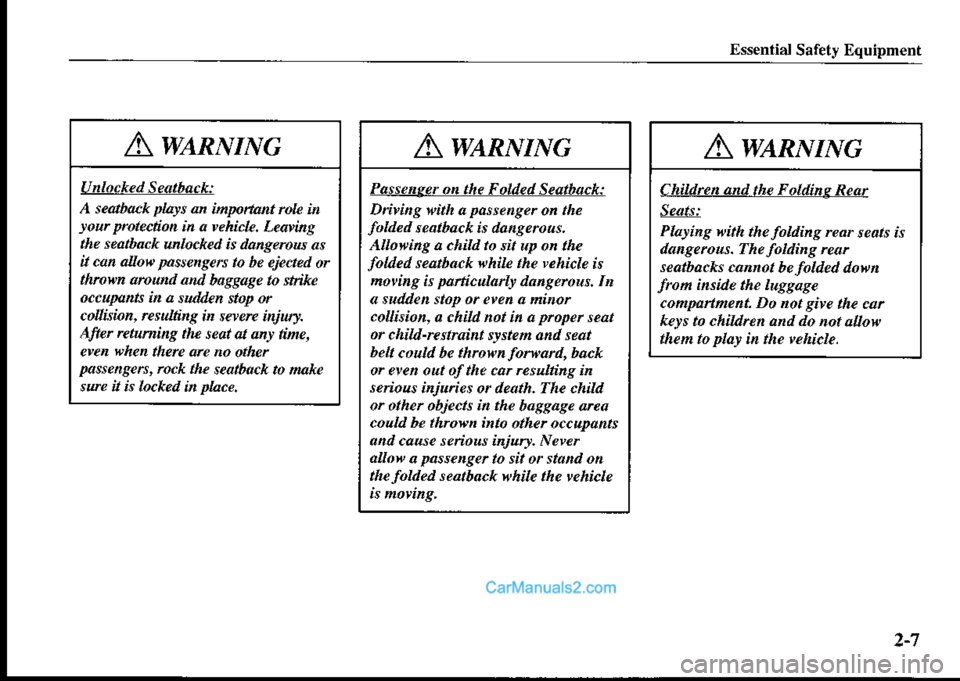
Essential SafetJ Equipment
A wanlvnvc
Unk'cked Seatback:
A seatback plart an irynrtant rola i,t
rour prctection in a rehi.le. Leavirrg
the seatback unlocked is dangerout as
it can alloui passengers to be ejeded or
thmvn aroutrd a d baggage to stike
occupa ts i a suAkn stop or
collbi , rcsuxing in sewre injwr.
Afrer rctuming th? seat at anf line,
even when there are no otherpassengers, ro.k ttu seatbeck to nnke
swe itis locked i place.
A waRlrlvc
P a s s e n qsralLLfu ldalslalbaeL!
Driving with a passe ger on the
fotded 'eatback is danserous.
Auor)ing a child to sit up on the
foued seatbatk rrhile the whicle is
moving k particulaflr dangerour. In
a su.Uen stop or ewn a minor
.o ision, a chiU not in a oper seat
or chiu-restraint srstem and seat
bett could be thnwn fonra , back
or eye out of the ca. .esultins in
senous injuries or death.The chiu
or othel objecs itt the baggage ana
could be thrcwn into otheroccupants
&nd cause senous injur!. Never
alk'|| a passengerto sitor stand on
the fotded seatbock v,hile the vehicle
AWARNING
Childft and the Fotding Rear
Js46i
Plaring vith the folding reot seats is
dangercus. 1:he foldiig rcar
seatbacks cannot be folded doi'tl
Jion inside the luggage
comparlment Do not give the car
kers to chidrc and do not a otr
then to plar in the whi.lc.
Page 20 of 290
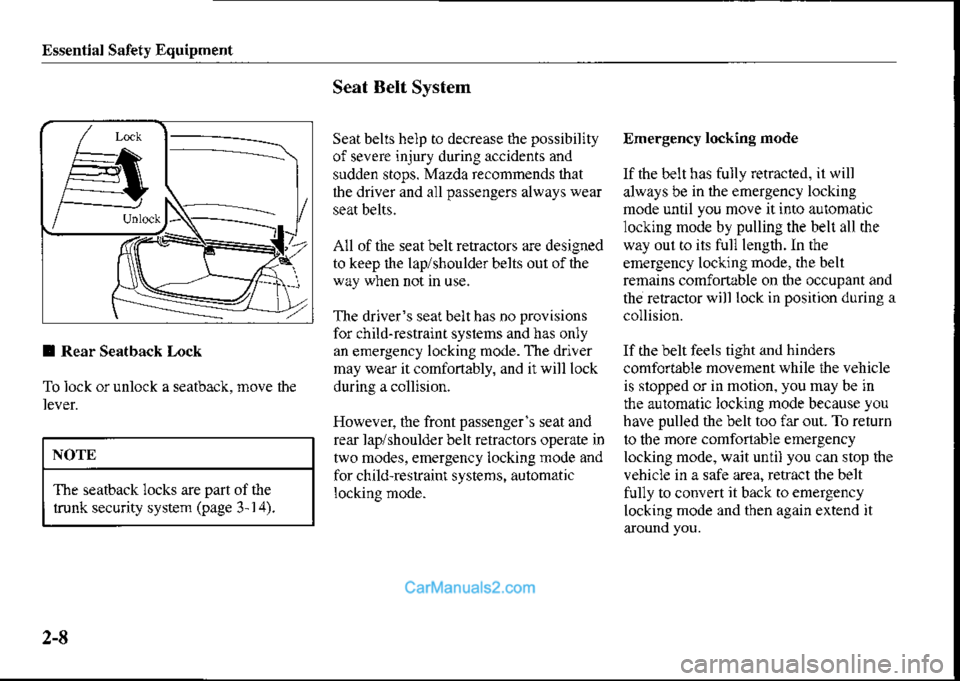
Essential Safety Equipment
I Rear S€atback Inck
To lock orunlock a seatback, move ihe
NOTE
The seatback locks are part of the
lrunk security systen (page 3- I ,1).
Seat Belt System
Sealbelts help to decrease the possibility
of severe injury during accidents and
sLrdden stops. Mazda recommends ihat
lhe driver and all passengers always wear
All of the seat belt retractors are designed
to keep rhe lap/shoulder belts out oi the
way when not n use.
The driver's seatbelthas no provisions
fo! child-restraint syslems and has only
an emergency locking mode. The driler
nay wear ir comfortably, and iiwill lock
during a collision.
However, the front passenger seat and
rear lap/shoulder belt retractors oper4te in
two modes, energency locking mode and
for child'resrainr systens, automatic
Emergency locking mode
lf the belt has fully rerracled, il will
always be in ihe emergency locking
mode until you move it into automatic
locking node by pulling the belt all the
way oul io its full leng$.In the
emergency locking mode, the bell
remains comfortable on the occupant and
the retractorwill lock in position during a
If the belt feels tight and hinders
comforoble movement while rhe vehicle
is slopped or in motion. you may be in
the aubmatic locking mode because you
have pulled the belt too far out. To reiurn
to the more comfonable emergency
locking mode, wait until you can stop the
vehicle in a safe area, retract the belt
fully to convert it back to emergency
locking mode and then again extend it
2-8
Page 21 of 290
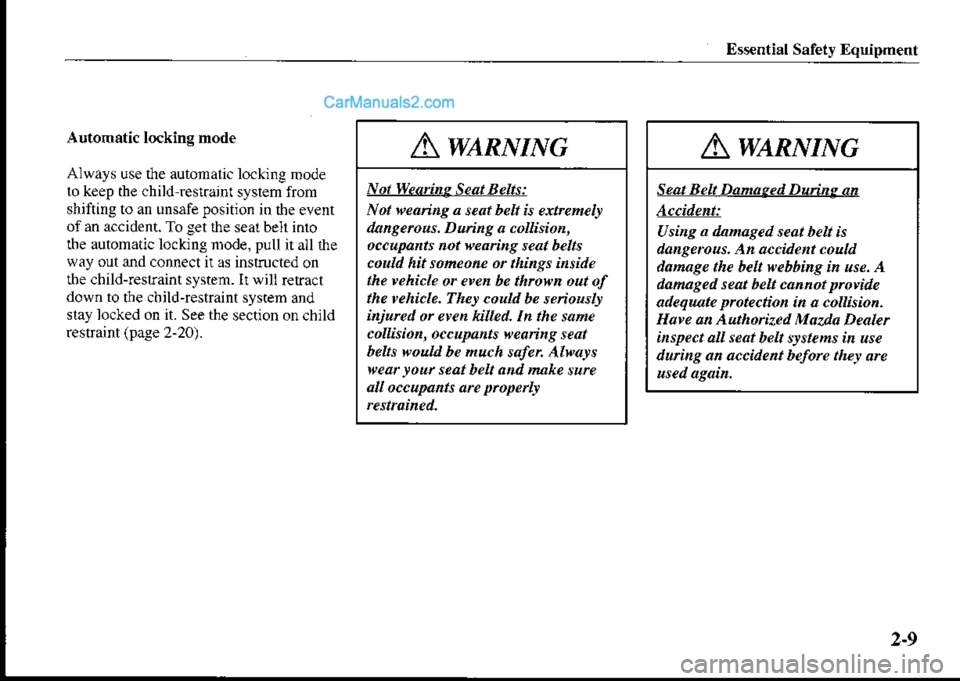
Ess€ntial Safety Eq pment
Automatic locking mode
Always use the automalic locking mode
1() keep the child restajnt system from
shifting to an unsafe position in the event
of an accident. To get the seat bell imo
lhe automaric locklng nrode. pull irall rhe
way out and connect it as instl-ucted on
the child-resaaint system. hwill retract
down to tle child'restraint system and
slay locked on it. See the section on chlld
restraint (page 2-20).
Awannmc
Not Weafing Seat Belts:
Not *'ean g a seat bek is ext emelr
dengerc s. Dunng a co ision,
occuqants not wearing reat belts
could hit someone or things i ride
the rehi.le or even be thrown out oI
the rehicle.Ther could be seiourlr
injurcd ot even kilted.In the sane
collision, occupants treaing seat
belts \|oua be nuch sder Atwars
weartoo seatbelt and ruke surc
a occupants arc prcpe r
A warurnrc
Seat Belt Danared Duing an
Accident:
Usins a danaged seat belt is
dangerous. A accident.ould
danage the belt webbing in use. A
danaged seat belt cannot proride
a.lequate protection in a collision.
Hare a Authorized Mazla Dealer
inspe.tall seatbelt slstems in use
during an accident before the! .re
2-9
Page 32 of 290
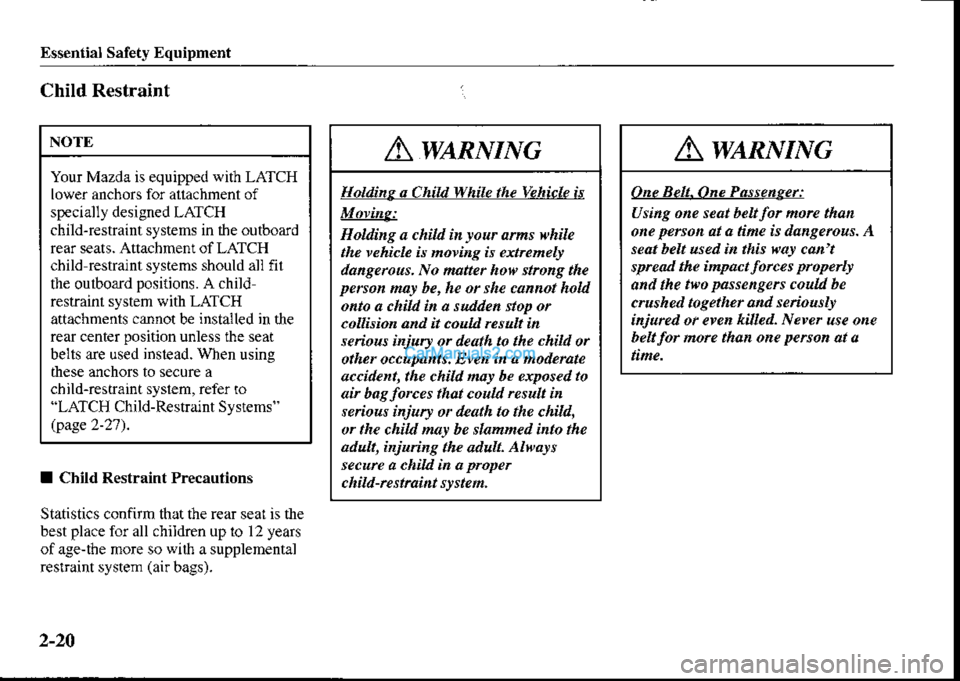
Ess€niial Safety Equipment
NOTE
Your Mazda is equipped with LATCH
lower anchors for allachment of
specially designed LATCH
child-restraint systens in $e outboard
rear seats. Anachment of LATCH
child restralnt sysiems should all fil
the oulboard positions. A child
restrainl system with LAICH
anachments cannor be installed in the
rear center positionunless the seat
belts are used instead. When using
these anchors to secure a
child-resiraini syslem, refer to
"LATCH Child-Restraint Systens"(paze 2-21).
A wanlrnrc
Holding a Chia white the Vehicte it
Moing:
Hodins a chiu in rour atms vhile
tha whicle is noins is ext.enelr
dangercus. No nutter ho$, strong the
person nut be,he or she cannot hou
onto a chiU i asudden stop or
tolision and it coud res ltin
seious injury or death to the child or
other o.cupants. Ewn in a moalerate
accident, the child mar be exposed to
ab bas Iorces that couA nsult in
serious injury or daath to the child,
or the chiu nat be slanned into the
adult, injuing the adult. Altrolt
secuft a chid in a ptupe.
c hild-re straint s r ste n.
Child Restraint
I Child Restraint Precautions
Statistics confirm that the rear seai is the
best place for all children up io 12 years
of age-tbe more so with a supplenental
restraint system (air bagt.
A wamrnrc
One BeIt- One Passenger:
Using o e seat belt|br more than
o e person ata tine is dangercus. A
seat belt used i,t this Ha! can't
spread the impactforces ploperry
onil the twopassengers couu be
crushed together attd seriouslr
injured ot even ki ed. Neret use one
beltlor nore than one person at a
2-20
Page 33 of 290
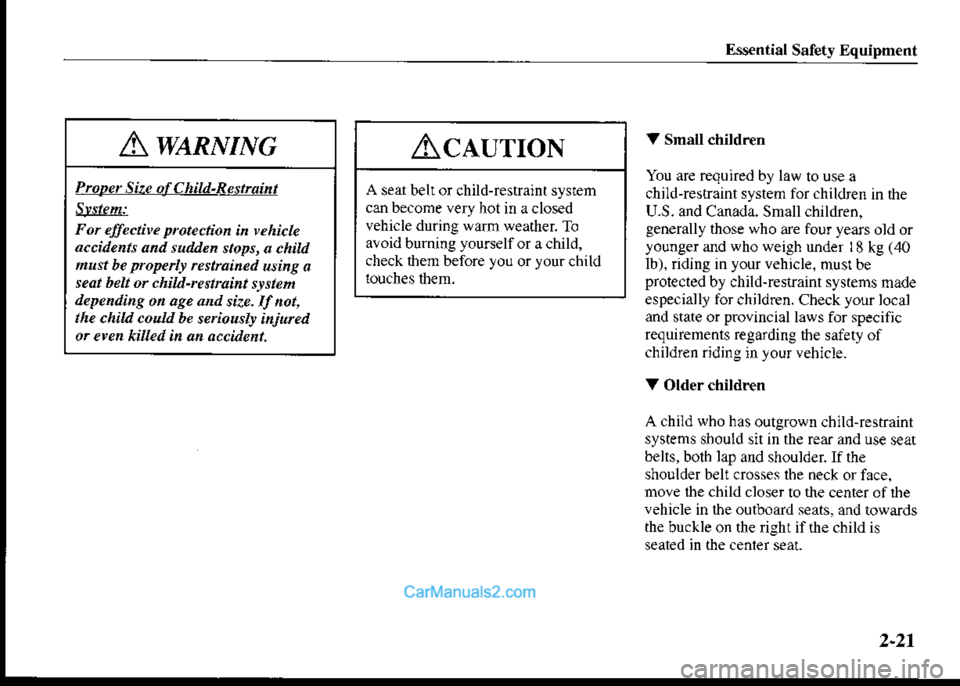
Essential Safety Equipm€nt
A wanlunyc
P I opcdize lf eltild.R e s t ruht
SJst rr..
For eJfective prctection in r.hicle
accidents and s dden stops, a child
nust be prcperlr rcsbained using a
seat belt or chiA-restraint s}ste,l
dependins o ase and ske. If not,
the chid coud be seriouslr injured
or eren killed in an accident.
Ac.lurroN
A seat bel!or child-restralnt sys|em
can become very hot in a closed
vehicle during warm weafter. To
avoid burning yourselfor a child,
check them before you oryourchild
V Small children
You are required by law to use a
child'restr3int system for childrcn in the
U-S. and Canada. Small children,
generally those who are four years old or
)ounger and who weigh under l8 kg (4O
1b). riding in your vehicle. rnus! beprotected by child-restraint systems made
especially forchildrcn. Check your local
and state or provincial laws for specific
requirenents regarding $e safety of
children riding in tour vehicle.
V Older children
A child who has outgrcwn child-restraint
systems should sit in the rear and use seat
belts, both lap and shoulder.Ifthe
shoulder belt crosses the neck orface.
move lhe child closer to the center ofrhe
vehicle in the outboard seats. and rowards
the buckle on the right if rhe child is
seated in the cenier sea!.
2-21
Page 34 of 290
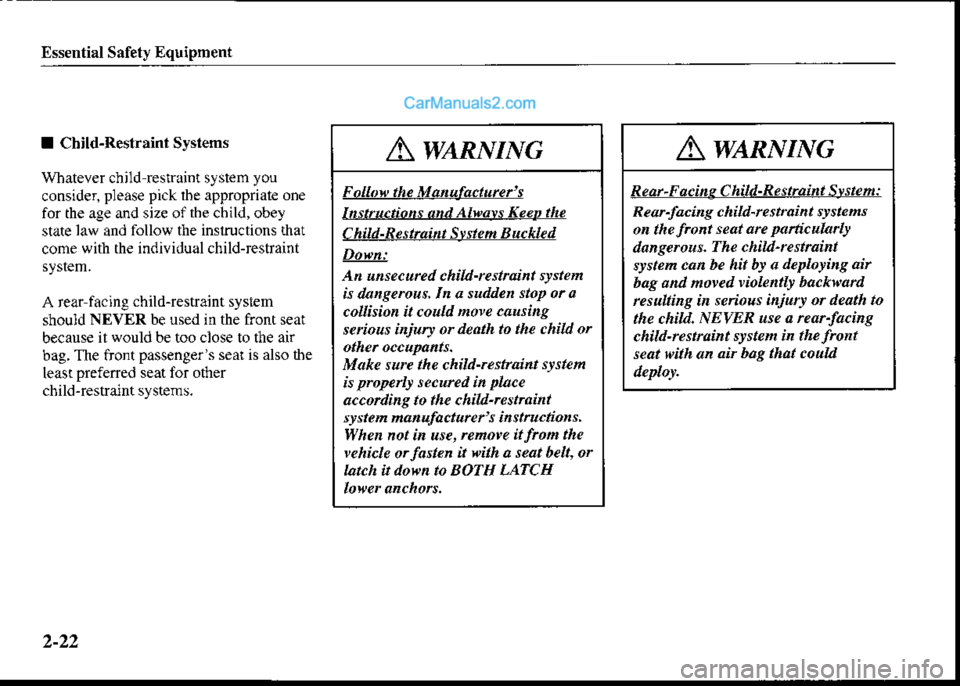
Essential Safety Equipnent
A waRlrnrc
Fo ow the Manufacturcr\
Instructions and Alwa\s Keep the
C hid-Restraint Slstem Bucued
Dp!4!
An unsecured chiA-rcstraint srsten
is dangerous.In a sadden stopora
co ision it could now caasing
sefious injury ordeathtothe chiu or
Make sure the child-.estraint sJsten
is proryrb secured in pLace
according to the chiuaestni t
srstem ma ufacturer's instructions.
When not in use, nmore itlrom the
whicle o4.tun it with a seat belt, or
bt.h i! dogn to BOTH LATC H
I Child-Restraint Syst€ms
Wlatever child resrrarnr system you
consider. please pick fte appropriat€ one
for the age and size ofthe child, obey
state law and follow the inslructions tha!
come with the individual child-rcstraint
A rear facing child-restraint sysl,em
should NEVER be used in the front seat
because ii would be too close to the air
bag. The front passenger's seat is also the
least prefened seat fbr other
child-restraint systems.
A wenlgr.r'rc
Reaft F ac ing C hild- Re etuint S! ste n :
Rearfacins child-lestnint srst ns
on the tont seat are partic ul4rlr
dan ge rcu t. The c hiuae straint
srstem can be hit br a deploring air
bag and moved iole tlr ba.krard
rcsulting in seious injury or death to
the chid. NEVER use a rcarfacins
chiu-restruint srsten in thefrcnt
seat $,ith an air bag that coLA
2-22
Page 35 of 290
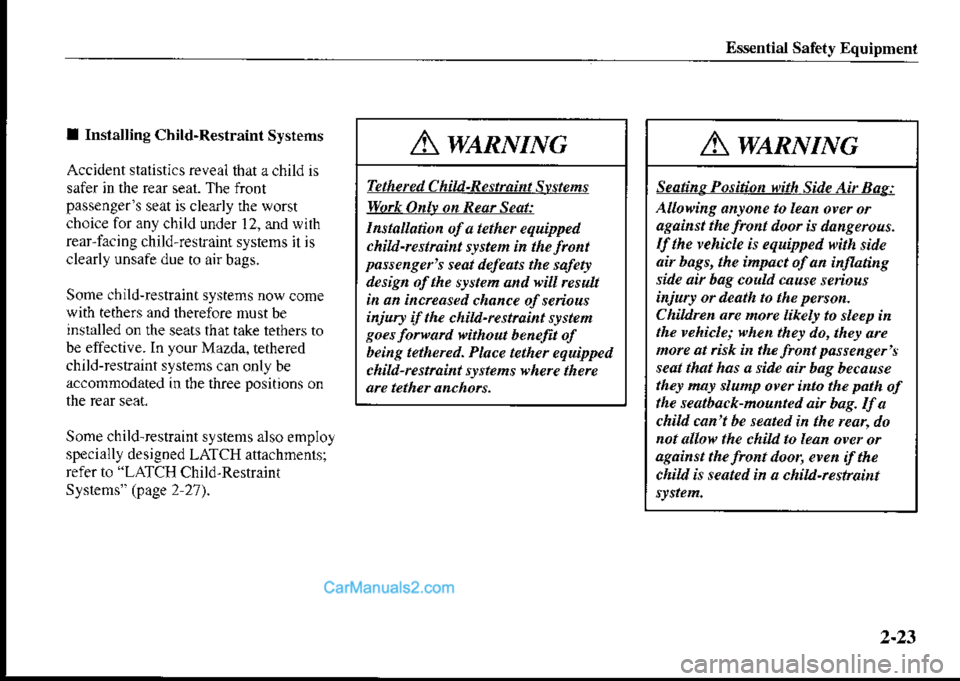
Ess€ntial Safety Equipment
I Installing Child-Restraint Slstems
Accident statistics reveal that achild is
safer in the rear sea1. The front
passengeas seat is cl$fly rhe worst
choice for any child under 12, and with
rearfacing child-restraint systems il is
clearly unsafe due to airbags.
Some child-restraint systems now come
with tethers and therefore must be
instdled on lhe seais thai take tethers to
be effective. In your Mazda. tethered
child-restraint systems can only be
accommodated in tbe three positions on
Sorne child-restraint systems also emplo]
specially designed LAfCH attachmenls;
refer to "LATCH Child-Restraint
Stslems" (page 2 27).
Awtnu^tc
Tethercd C hia-Resttuint S$tems
wo* Onb on Rear Seat:
Insto ation of a tether equipped
chiu-rcstraint ststem in the fuo t
Ntsenger seat delbats the safetr
des;gn ofthe srsten and wi result
in an incleased chonce ofseious
inju.r if the chiaaestruint srsten
soes foNad without benefit of
being tethercd. Place tether equipped
.hild-restruint slstens wherc therc
Awenumc
Seating Positiotr t!,ith S le Ab Bag:
A owing anrone to lean orer or
against the front door is dangercus.
If the yehicle b equrrped h,ith side
air boes, the inpact of an infuting
side ab bag could cause serious
Wury or death to the percon.
Chiuren arc norc likelr to sleepin
the vehicle; when ther do,ther aR
nofe at sk in the ffont passenge.'s
seat that has a side air bag because
the! nu! slump owr i,tto th. poth oI
the seatba.k-nounted air bag. If a
chiucan't be seated in the rear, do
not a oh, the chid to lean ovat or
agdinst the front door, eve if the
chid is seated in a chiA-ftstraint
2.23
Page 36 of 290
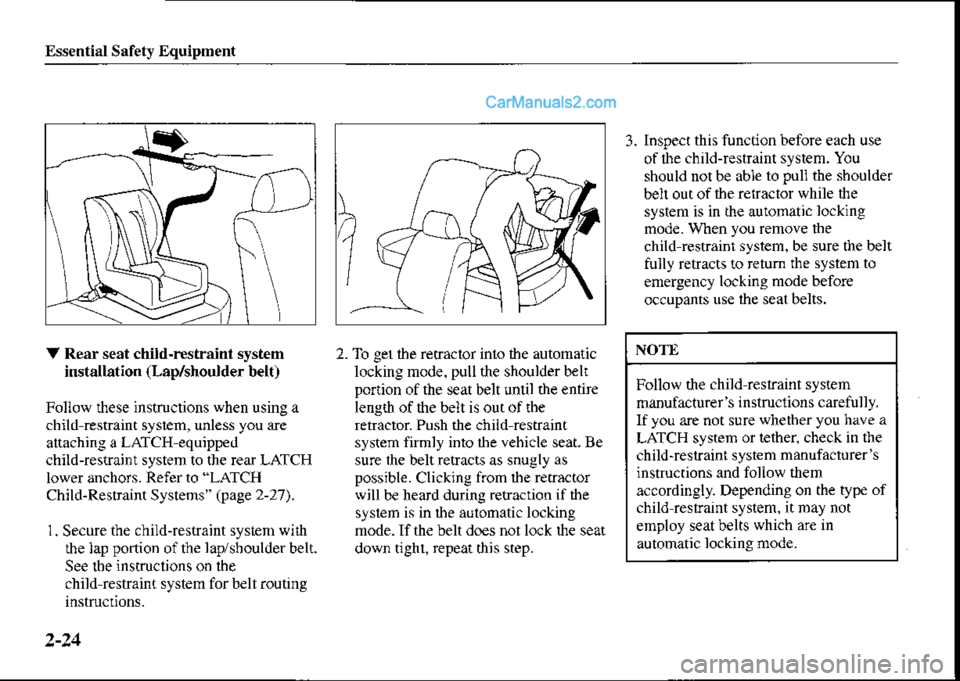
Essential Safety Equipment
3. Inspect this function before each use
of lhe child-restraint system. You
should notbe able to pull the sboulder
beh outofthe relracior while the
system is in rhe auromatic locking
mod€. When you remove tbe
child restraint system. be sure the belt
fully retracts lo retum the system to
emergency locking mode before
occupants use ihe seal belts,
V Rear seat child-r€straint system
installation (Lap'/shoulder belt)
Follow lhese instructions when using a
child restraint syslem, unless you are
auaching a LATCH equipp€d
child-restrain! system to the rear LATCH
lower anchors. Refer to "LATCH
Child-Restraint Systems" (page 2-27).
l. Secure the child-restraint sysien with
the lap podon of the I adsboulder belt.
See fte instructions on the
child restraint system for beli routing
2- To gel ihe retraclor inlo the automatic
locking mode. pull the shoulderbell
porrion of the seat belt until the entire
length of the belt is out of ihe
retractor Push the child restraini
system firmly into $e vehicle seat. Be
sure lhe belt retracts as snugly as
possible. Clicking from the retracior
will be heard during retra.iion ifthe
slslem is in the aulomatic locking
mode. If the belt does noi lock the seat
down tight. repeat th's step.
NOTE
Follow the child resiraini syslem
manufacturer's instructions caref ully.
lf you are not sure whetber you hav-- a
LATCH system or tether, check in the
child-restraint system manufacturer's
instructions and fbliow them
accordingly. Depending on the type of
child resiraint system. itmay not
employ seat belts which are in
automaric locking mode.
Page 37 of 290
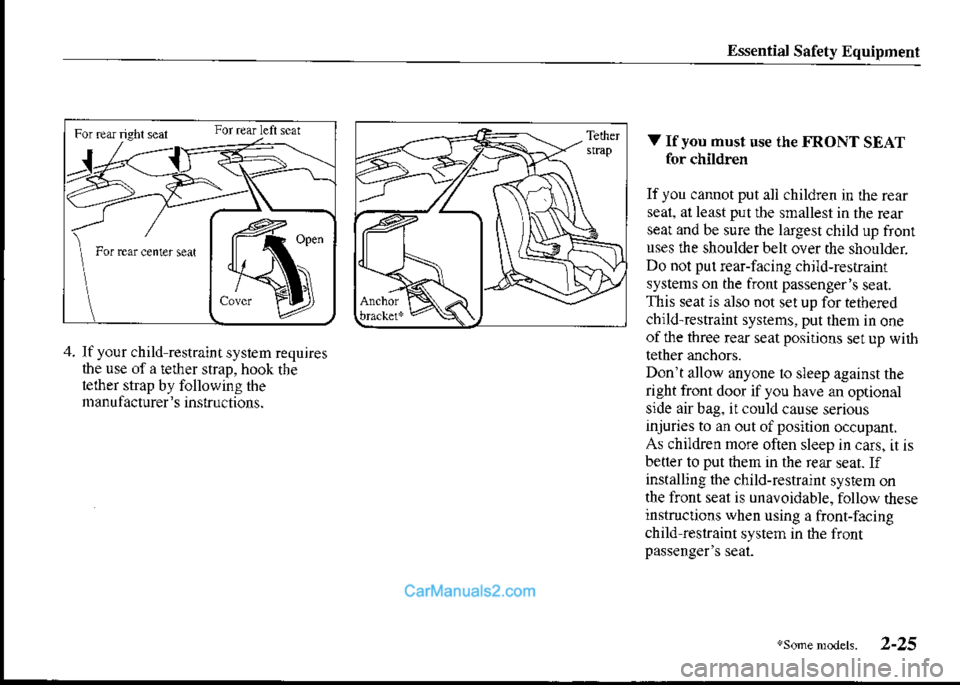
Essential Safety Equipment
For earngbl sal ror rear len $d
4. Ifyour child restrainisysiem requiresthe use ofa |elher strap, hook thel,ether strap by following thenranulacturer's inslructions.
V If you must use th€ FRONT SEAT
for children
Ifyou cannot put ali children in the rear
seal. al least put lhe smallest in the rear
sea! and be sure the largest child up fronr
uses lhe shoulderbelt over rhe shoulder
Do not put reaFfacing cbjld,resrrainr
systems on the fronr passenger's seat.
This seat is also not set up for tetber€d
cbild-restraint sysrems. put them in oneof the tbree rear seat posirions set up wiih
Don't allow anyone 10 sleep against the
right front door if you have an optional
side airbag. itcould cause serious
injuries to an out ofposition occupant.
As children more often sleep in cars, it isbetler to put them in the rear seai_ If
ins(alling tbe child-restraint system on
the front seat is unavoidable, follow rhesenstruclions when using a front-facing
child reslraint system in the front
:sone modek. 2-25
Page 38 of 290
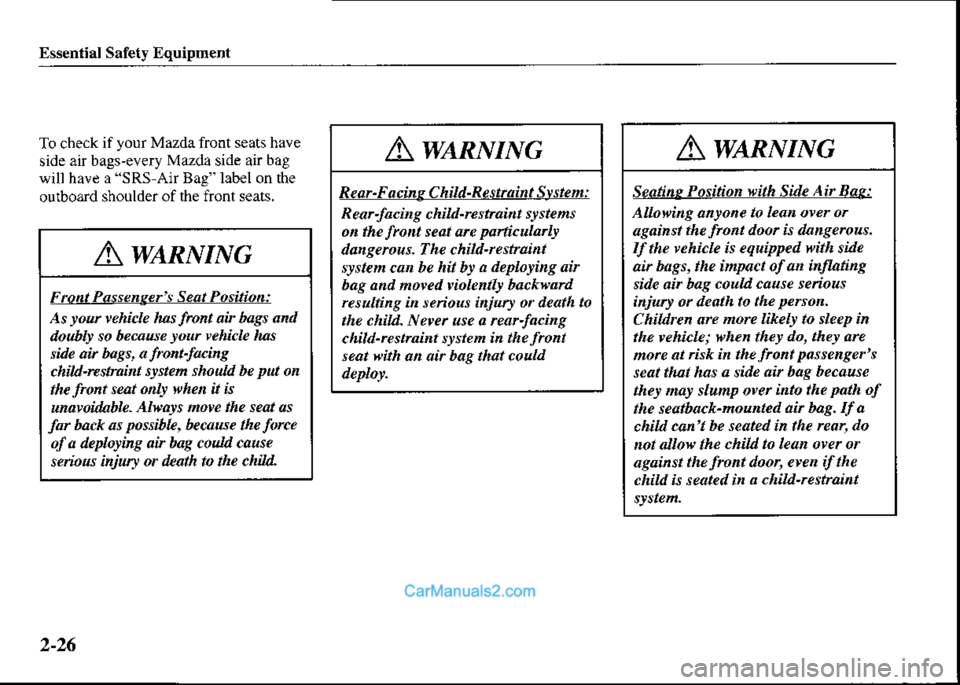
Essential Safety Equipment
AwtnNuvc
Re ar- F acing C hild-Re sttuint S! ste n :
Rearfacing child-restraint srstens
o the lront seat are particula j
dange rcu s. T he c hild-re straint
srstem can be hit b! a deploring air
bag and nowd violentlr backwa
resulting in senous i jury or death to
the chid. Newt use a rear-locing
child-rcstraint trsten in the frcntseat eilh anair bae thatcould
To check ifyour Mazda front seats have
side air bags'every Mazda side air bag
will have a"SRS Air Bag" label on the
ou$oard shoulder of the liont seats.
rl^wl,nr,uuc
Seatins Position vith Side Air Bag:
A oeing anrone to lean orq o.
aeainst the front door is dangercus.
If the t'ehi.le b equipped with side
air bags, the impact of an i,tlating
side ab bag couu cause senous
injury or deoth to the person.
Children are more likelt to sleep in
the t'ehick; h,hen the! do, the! are
more at .isk in the front passenger's
seat thet has a side ab bag because
thej mal slump o't into the path of
the seatback-nounted 4h bae. If a
chu can't be seated in the nar, do
not dlow the chiA b kan over or
against the fmnt door, eren if the
chiu k seated in a .hid-.estraint
A wanlunvc
Frcnt Passenger's Seat Posuion:
As tot whicle has front air bags and
doublr so becaue !oa. whi.le has
side ab bass, a frcnt-tacins.hu-restraint slsren shouu be pa on
the front seat onry ,'ehen it is
unavotlable- Ahta]s mow the seat as
Iar ba* as possibla, because the forceof a deploJing oir bag cou.lt cause
serb s injuq or daath to the chiw
2-26